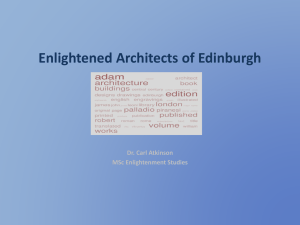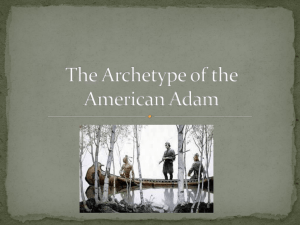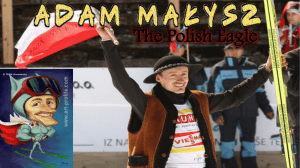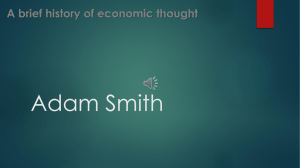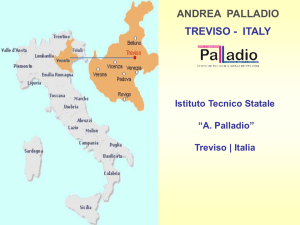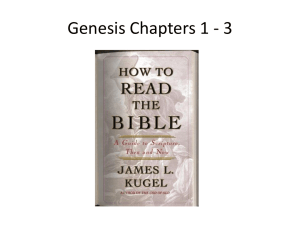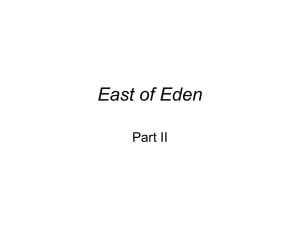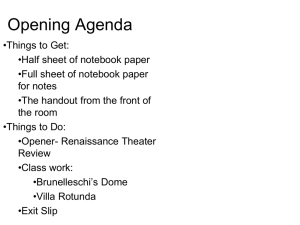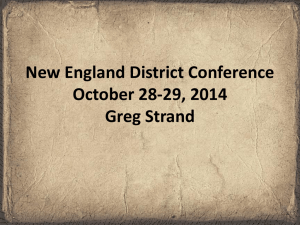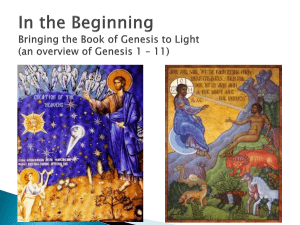A Genealogy of Architectural Books relating to the
advertisement
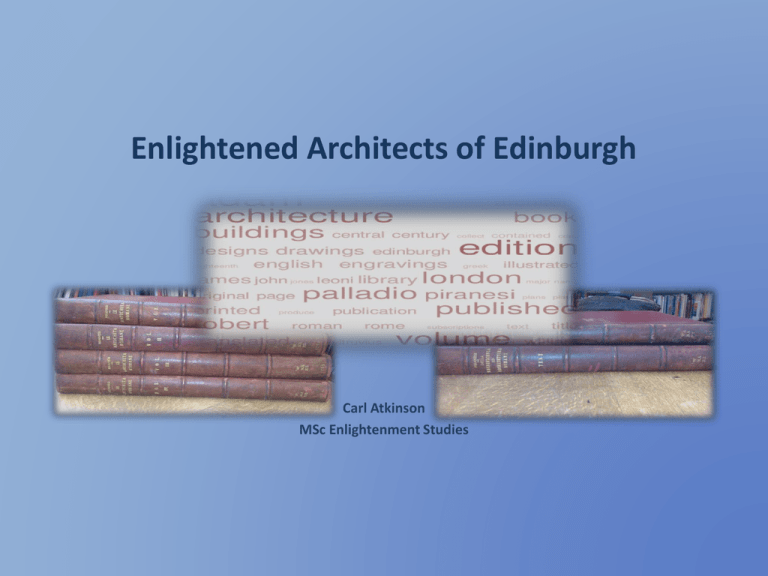
Enlightened Architects of Edinburgh Carl Atkinson MSc Enlightenment Studies The enlightened architects of Edinburgh ... William Adam Andrea Palladio Piranesi John Adam Robert Adam James Adam An enlightened circle of friends ... Alexander Wedderburn James Boswell Allan Ramsay Sir John Clark John Home David Hume Colin Maclaurin William Robertson Alexander Carlyle Adam Ferguson Adam Smith James Hutton The texts in the library Andrea Palladio The Architecture of A. Palladio ,1742 (1715-20) William Adam Vitruvius Scoticus, 1812 Andrea Palladio I quattro libri dell’ architettura ,1737/8 Joannis Batista Piranesi The Magnificent and Architecture of Rome, 1761 The texts of brothers Adam Esquires Robert and James Adam The Works in Architecture (Peter Elmsly, 1778) Robert Adam Ruins of the Palace of the Emperor Diocletian at Spalato in Dalmatia Robert and James Adam The Works in Architecture (French reprint of 1900-2) The philosophy of beauty in the Scottish Enlightenment “The figures which excite in us the ideas of beauty seem to be those in which there is uniformity amidst diversity ... What we call beautiful in objects, to speak in the mathematical style, seems to be in a compound ratio of uniformity and variety; and where the variety is equal, the beauty is as the uniformity” Frances Hutcheson, Inquiry into the Original of Our Idea of Beauty and Virtue, 1725 “...we have a taste for proportion independent altogether of utility. One thing indeed is certain, that any external object proportioned to our taste is delightful” Henry Home, The Elements of Criticism, 1762 “But the beauty arising from regularity and variety , must always yield to that which arises from the fitness of the form for the end intended” Thomas Reid, Of Beauty - Essays of the Intellectual Powers, 1785 “Beauty is such an order and construction of parts, as either by the primary constitution of our nature, by custom, or by caprice, is fitted to give a pleasure and satisfaction to the soul” David Hume, On Beauty and Deformity, 1739 “Beauty is no quality in things themselves: it exists merely in the mind which contemplates them; and each mind perceives a different beauty” David Hume, On the Standard of Taste, 1757 “...Utility is one of the principal sources of beauty ... The convenience of a house gives pleasure to the spectator as well as its regularity, and he ids as much hurt when he observes the contrary defect, as when he sees the correspondent windows of different forms, or the door not placed exactly in the middle of the building ” Adam Smith, The Theory of Moral Sentiments, 1759 The philosophy of architecture according to Palladio Andrea Palladio, The Architecture of A. Palladio The philosophy of architecture according to Adam “It is not always that such variety can be introduced into the design of any building but where it can be attained without encroaching upon its useful purposes, it adds much to its merit, as an object of beauty and grandeur” Robert & James Adam, The Works in Architecture, Preface to Volume I Number 1, 1773 “Architecture has not, like some other arts, an immediate standard in nature, to which the artist can refer, and which would enable the skilful instantly to decide with respect to the degree of excellence attained in any work. In architecture, it must be formed and improved by a correct taste, and diligent study of beauties exhibited by great masters in their productions; and it is only by profound meditation upon these, that one becomes capable of distinguishing between what is graceful and what is inelegant; between that which possesses, and that which is destitute of harmony ” Robert & James Adam, The Works in Architecture, Preface to Volume I Number 2, 1774 “Whether our works have not contributed to diffuse these improvements in architecture, throughout this country, we shall leave to the impartial public” Robert & James Adam, The Works in Architecture, Preface to Volume I Number 1, 1773 “Architecture has already become more elegant and more interesting. The parade, the convenience, the social pleasures of life, being better understood, are more strictly attended to in the arrangement and disposition of appartments. Greater varoety of form, greater beauty in design, greater gaiety and elegance of ornament, are introduced into interior decoration; while the outside composition is more simple, more grand, more varied in its contour, and imposes on the mind from the superior magnitude and movement of its parts.” Robert & James Adam, The Works in Architecture, Preface to Volume I Number 5, 1778 “Without detracting from the talents and merit of other artists, we are encouraged, by the public approbation, to flatter ourselves, that our works have somewhat contributed to diffuse juster ideas and better taste in architecture” Robert & James Adam, The Works in Architecture, Preface to Volume I Number 5, 1778 The Images I ... Andrea Palladio, Villa Pisani William Adam, Mavisbank House The Images II Piranesi Terme di Tito & Port of Ripetta, Rome Robert Adam Port at Spalato & Syon House The buildings I Adam Family - Hopetoun House, nr Edinburgh Robert Adam - Charlotte Square, Edinburgh The buildings II The Project Deliverables ... A Genealogy of Architectural Books of the Adam Family: Eighteenth Century Architectural Treasures in the Central Library’s Fine Art Collection This paper describes the various architectural editions held in relation to their publication history whilst providing a short commentary on the origin of and influences contained within the editions. They are set out in chronological order. A. Andrea Palladio’s I quattro libri dell’ architettura or The Architecture of A. Palladio in Four Books) Andrea Palladio was an architect active in the Republic of Venice. Influenced by Roman and Greek architecture, he is widely considered the most influential individual in the history of Western European architecture. In addition to his significant achievements as an architect, he was an accomplished author and illustrator who produced a number of books of architectural drawings that were in many personal libraries and widely read. The most famous of his books is ‘I quattro libri dell’ architettura’, initially published in four volumes in Venice in 1570, illustrated with woodcuts after the author’s own drawings. It contains Palladio's own designs celebrating the purity and simplicity of classical architecture. Whilst some of these ideas had not progressed further than the drawings, others, in particular the designs and plans for villas, had been successfully built for clients in the Veneto. Palladio drew inspiration from surviving Roman buildings, Roman authors, especially the architect Vitruvius, and Italian Renaissance architects. However, ‘I quattro libri dell'architettura’ provided systematic rules and plans for buildings which were creative and unique. Palladio’s villa style is based on details applied to a structural system built of bricks. He offers two types of general rules in the corpus: design rules (those based on appearance) and construction rules (those based on the logic of villa construction). As a consequence, the volumes includes essays on building materials, the classical orders and decorative ornaments, Palladio’s own designs and his reconstructions of Greek and Roman designs, plans for ancient towns, bridges, highways, and basilicas, and plans for the reconstruction of early Roman temples. The book inspired numerous patrons and other architects, including Inigo Jones who on visiting the villas in Veneto in 1610 wrote that ‘All of Palladio’s works are lighter than in the drawings’. Palladio’s villas became an important stop on the Grand Tour for northern European literati during the eighteenth century. Palladian architecture grew in popularity across Europe and, by the end of the 18th century, had extended as far as North America. The books were subsequently reprinted and translated in many editions, mainly in single and two volume formats, in English, French, Spanish, German, Russian, Swedish, Polish Romanian and Czech. At least twenty three English language editions were published during the eighteenth century alone. Bibliography ... Primary Sources in the Fine Art Library, Central Library, Edinburgh Palladio, A., I quattro libri dell’ architettura or The Architecture of A. Palladio in Four Books (1570). Editions by: Isaac Ware, London, (1737/8) Leoni & Dubois, publisherd by Ward, Birt, Browne, Davis, Osbourne & Millar, London, (1742) Adam, W., Vitruvius Scoticus (1812). Black & Robertson in London and Underwood & Taylor in London. Ward, A., Architecture (1750s). London: self published. Adam, R., Ruins of the Palace of the Emperor Diocietian at Spalato in Dalmatia (1764). London: private. Piranesi, J.B., Le Antichita Romane (1756). Rome: unknown. Piranesi, J.B., The Magnificent and Architecture of Rome (1761). London: Antiquarian Society of London. Adam, R. and J., The Works in Architecture (1778). London: Elmsly . Adam, R. and J., The Works in Architecture (1900/2). Dourdan: Thezard. Adam, R. and J., The Architecture, Decoration and Furniture of Robert and James Adam (1880). London: BT Batsford. Secondary Sources Black, J., The British Abroad: The Grand Tour in the Eighteenth Century (1992). Stroud: Sutton. Flaming, J., Robert Adam and His Circle in Edinburgh & Rome (1962). London: John Murray. Gifford, J., William Adam: A life and times of Scotland’s universal architect (1989). Edinburgh: Mainstream/RIAS. Graham, R., Arbiter of Elegance: A Biography of Robert Adam (2009). Edinburgh: Birlinn. Klein, L. E., Politeness and the Interpretation of the British Eighteenth Century, The Historical Journal, Vol. 45 (4), December 2002, pp. 869-898. Sanderson, M.H.B., Robert Adam and Scotland (1992), Edinburgh: Scottish Records Office. Tait, A.A., Robert Adam: Drawings and Imagination (1993). Cambridge: Cambridge University Press.
